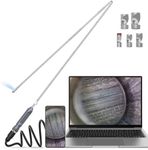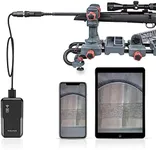Buying Guide for the Best Borescope For Rifle Barrels
Choosing a borescope for rifle barrels is all about finding a tool that helps you clearly inspect the inside of your firearm’s barrel for fouling, damage, or wear. The right borescope will make it easy to spot issues that could affect accuracy or safety, and it should be simple to use, durable, and compatible with your firearms. When shopping, focus on the features that will make your inspections effective and comfortable, and think about how you plan to use the borescope—whether for occasional checks or regular, detailed inspections.Probe DiameterProbe diameter refers to the thickness of the part of the borescope that goes inside the barrel. This is important because it needs to fit easily into the bore without getting stuck or scratching the rifling. Rifle barrels come in different calibers, so you want a probe that is thin enough for your smallest barrel. Probes typically range from about 3.9mm to 5mm in diameter. For small-caliber rifles, a thinner probe is essential, while larger calibers can accommodate thicker probes. Always check your rifle’s caliber and choose a probe that is comfortably smaller to ensure smooth operation.
Probe LengthProbe length is how long the borescope’s insertion tube is. This matters because it determines how far into the barrel you can see. For most rifles, a probe length of 16 to 24 inches is sufficient to inspect the entire barrel from one end. If you have longer barrels or want to inspect from both ends, a longer probe may be helpful. Choose a length that matches the longest barrel you plan to inspect, but avoid excessively long probes if you only have short barrels, as they can be harder to handle.
Image Quality (Resolution)Image quality, often described by resolution, tells you how clear and detailed the pictures or videos from the borescope will be. Higher resolution means you can see finer details, which is important for spotting small cracks, pitting, or fouling. Resolutions can range from standard definition (around 640x480) to high definition (720p or 1080p). If you want to do detailed inspections or document your findings, go for higher resolution. For quick checks, lower resolution may be enough. Think about how much detail you need to see and how you plan to use the images.
Lighting (LED Illumination)Lighting refers to the built-in LEDs at the tip of the borescope that illuminate the inside of the barrel. Good lighting is crucial because rifle barrels are dark and you need to see clearly. Most borescopes have adjustable LED brightness. More LEDs or brighter lights help in larger or dirtier barrels, while adjustable brightness lets you avoid glare in shiny barrels. If you often inspect in low-light conditions or want to see every detail, prioritize strong, adjustable lighting.
Viewing AngleViewing angle is the direction the camera looks inside the barrel. Some borescopes have a straight-ahead view, while others have a side-view (often called a mirror or angled view). Straight-ahead is good for general inspection, but a side-view lets you closely examine the rifling and chamber walls. Some borescopes offer interchangeable or dual-view options. If you want to check for wear or fouling on the barrel walls, a side-view is very helpful. Choose the viewing angle based on what you want to inspect most often.
Display and ConnectivityDisplay and connectivity describe how you see the images from the borescope. Some models have built-in screens, while others connect to your smartphone, tablet, or computer via USB or Wi-Fi. Built-in screens are convenient and portable, but may be smaller. Smartphone or computer connections can offer larger, clearer images and easier sharing or saving. Think about where and how you want to view your inspections—if you want instant, portable viewing, a built-in screen is handy; if you want to save or analyze images, connectivity to other devices is useful.
Durability and WaterproofingDurability and waterproofing refer to how well the borescope can handle regular use and exposure to cleaning solvents or moisture. A durable, waterproof probe is important because rifle barrels can be dirty or wet, and you don’t want your tool to break or corrode. Look for probes made from sturdy materials and rated as waterproof or water-resistant. If you plan to use the borescope frequently or in tough conditions, prioritize these features to ensure a long-lasting tool.














